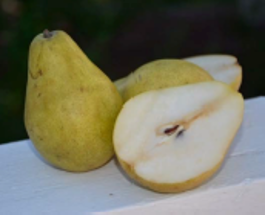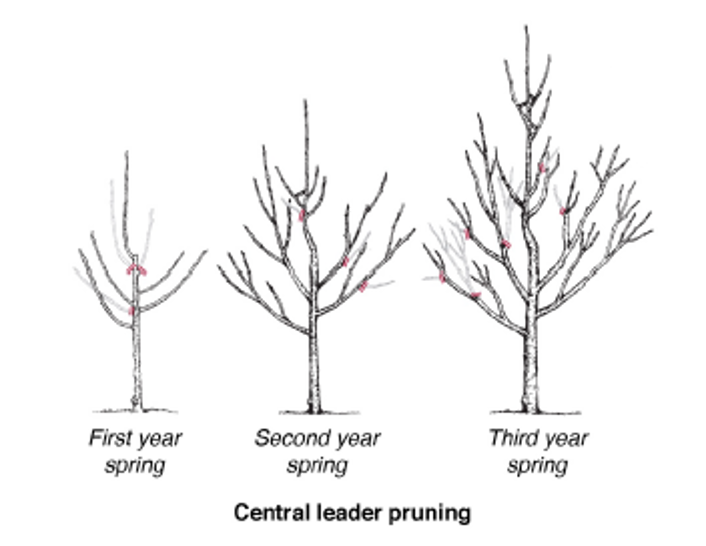How to Grow Pears in Your Home Orchard

Pears are a delectable treat of late summer and early fall. Most pears are cold hardy in the temperate parts of Utah. Common pears such as Bartlett, d’An-jou, and Bosc don’t ripen on the tree and require a period of cold storage following harvest before they are ready to eat. Asian pears will also grow in Utah. These pears are shaped like apples and they ripen on the tree.
Pears are very susceptible to the bacterial disease fire blight and this limits where they can be grown. Unfortunately, most fire blight in Utah is resistant to antibiotics. Removing infected wood is the best treatment for reducing the spread of fire blight.
How to Grow Pears
Cultivars
The most widely grown cultivar is Bartlett which is used for canning and fresh eating (Figure 1). Bartlett is partially self-fruitful but yields will increase with another pear cultivar close by. D’Anjou is selffruitful and is commonly used as a pollinator and stores well. Bosc has a long, narrow fruit with russetted skin and is good fresh, canned, and is especially fine for cooking.

Asian pears, sometimes nicknamed “apple pears” can be grown in Utah. The Asian pear fruit is round, crisp, and juicy (Figure 2). Unlike European pears, Asian pears ripen on the tree and do not require a storage or waiting period before using. Some popular varieties include 20th Century, Shinseiki, Hosui, and Shinko. Some varieties are selffruitful while others need a pollinator.

Pear Soil Preparation
Pear trees are adapted to many soil types but require well drained soil. They should not be planted where water stands for more than 24 hours unless soil drainage can be improved. Control perennial weeds in the area before planting by using tillage or a nonselective herbicide. Incorporate organic matter into the soil the year prior to planting.
Pear Tree Planting
Pear trees are produced by being grafted onto rootstocks which produce trees that grow about 25 feet tall (Hoover, Tepe, & Foulk, 2015). Allow 150 square feet of space for a mature pear tree. Some nurseries offer semi-dwarf rootstocks that are often from the Old Home x Farmingdale series, or OH x F, which are 70-80% of the standard size. Plant trees in the spring or fall. Trees can be transplanted in the summer months but it is much more stressful to the plant and careful attention to irrigation is critical. Trees can be purchased as bare root in the spring, or potted plants through the summer and fall. For bare root trees, dig a hole wide enough to easily spread all of the roots out and deep enough to cover the roots, but keeping the graft union 2-3 inches above the final soil line. Fill in the hole with the soil removed without amendments. Firm the soil around the roots and water immediately.
For potted plants, dig a hole the same depth and twice as wide as the root ball. If roots are circling the inside of the pot make vertical cuts with a knife and “fluff” the roots slightly as you plant the tree. Set the tree at a height to keep the graft union 2-3 inches above the soil line. Depending on rootstock and training system, pear trees will have a mature radius of 8 to 10 feet.
Pear trees should be staked at planting. Place the stake 2-3 inches from the trunk and fasten with nonmetallic fasteners. Staking helps protect the graft union and helps maintain the central leader of the tree.
Irrigation for Pear Tree Orchards
During the first year from planting, young fruit trees should receive 2-3 gallons of water a couple of times a week. Keeping new trees well irrigated during establishment is critical. Check the soil to ensure that it is moist to a depth of 6-8 inches near the tree. In subsequent years, trees will need 1-3 inches of water per week during the summer months and into the fall. It is best to irrigate less frequently with a deep soak to allow water to penetrate throughout the entire root zone. A deep irrigation that wets the soil to a depth of 18-24 inches every 7-10 days is preferred. This can be done using drip systems, soaker hoses, or hand watering. Avoid irrigating with sprinklers in order to keep the tree canopy dry, prevent foliar diseases, and minimize fruit exposure to untreated irrigation water. The fact sheet Orchard Irri-gation: Apple gives detailed irrigation instructions that also applies to pears.
Weed Control for Pear Trees
Keep vegetation (espe-cially turfgrass) at least three feet away from pear tree trunks. This prevents damaging the trunk by mowers and string trimmers and reduces competition allowing trees access to nutrients and water in this region. Unwanted grass can be killed with a nonresidual herbicide, then the area covered with a layer of mulch such as shredded bark or wood chips to reduce regrowth.
Fertilization for Pear Trees
Trees less than 3 years old should average about 12 to 15 inches of new shoot growth per year. If shoot growth is more than 24 inches, do not apply nitrogen fertilizer to trees. For underperforming trees 3 years old or less, apply ½ cup of 20-0-0, in a cir-cle around the root zone in early spring, before the tree forms leaves, and then water the fertilizer into the soil. A second application may be needed in mid-May. Do not fertilize after mid July. Bearing trees older than 4 years should grow approximately 1 foot per year (excluding the water sprouts). For trees not growing at this rate, apply 1 to 2 cups of 20-0-0 in early spring. If phosphorus and/or po-tassium are deficient (based on soil or tissue tests), apply a similar quantity of 16-16-16, or an equivalent balanced fertilizer.
Problems with Growing Pears
View more detailed information on pear insects and diseases.
Pears can sometimes set more fruit than they are capable of properly maturing. Thinning (selective removal of some small fruit) improves fruit quality by encouraging better color development and improved size of remaining fruit. Thin 2-3 weeks after petal fall by hand removing smaller fruit and leaving the largest pear in a cluster. Space remaining pears about every 6-8 inches along branches. Timing of thinning is critical. Thinning done later than a month after petal fall is ineffective.
Producing the best fruit requires control of diseases and insects. Fire blight develops when the weather is warm and rainy when pears are flowering. Codling moth, pear psylla, and mites are common pests of pear. The following fact sheets give detailed management instructions:
- Apple Production and Variety Recommendations for the Utah Home Garden
- Fire Blight
- Fruit Pests: Pear
- Pear Pest Monitoring Calendar
- Pear Psylla
- Pear Sawfly
Pruning Pear Trees
Begin pruning and training pear trees at planting. If the tree is unbranched, make a single cut 36 to 40 inches above the soil line. This will encourage side branches that will become permanent scaffold branches. In the first early spring following initial planting select the uppermost branch as the central leader. Keep the best 4-5 lateral branches below that as scaffolds. Pruning a young tree controls its shape by developing a strong, well balanced framework of scaffold branches. The preferred method of training pear trees in the home orchard is the Central Leader System (Figure 3). This produces a tree that is wider at the bottom than it is at the top (conical shape). This provides better illumination of all leaves than older “umbrella” or open center “vase” shaped trees. The fact sheet Training and Pruning Apple Trees gives detailed instructions.

How to Harvest and Store Pears
European pears (Bartlett, Bosc, Comice, d’Anjou, etc.) don’t ripen on the tree. Fruit left on the tree turn brown in the center and develop off flavors and odors. When mature, the skin color changes from dark green to a lighter green and the lenticels on the skin darken in color. On the tree, lift a pear up gently and twist. If the pear is mature, it will easily separate from the stem joint. For immediate use, refrigerate for a day or two, then keep the pears at room temperature to ripen. To have a large number of pears ripe at the same time for canning, place the pears in a box and cover with a blanket or newspaper in a cool place. Winter pears such as Anjou, Comice, and Bosc do not ripen immediately at room temperature but need storage in a cold refrigerator for 2-3 months immediately after harvest. After cold storage, remove from refrigeration and ripen at room temperature.
Asian Pears will ripen on the tree and can be used immediately. The video How to Pick and Store Pears gives information on harvest and storage.
Pears purchased at the grocery store should be stored at room temperature for 2-4 days before eating. They can be put into a paper bag which traps the ripening gas ethylene and the pears will ripen sooner. Ripe pears have a buttery melting flesh.
Pears can be successfully grown in the home orchard, but may require more care than some other tree fruits.
References
- Alston, D., & Murray, M. (2007). Pear psylla. Utah State University Extension ENT-62-07. Available at: https://extension.usu.edu/juab/ou-files/PearPsyl-laCacopsyllaPyricola.pdf
- Black, B., Hill, R., & Cardon, G. (2007). Orchard irrigation: apple. Utah State University Extension. Available at: https://digitalcom-mons.usu.edu/cgi/viewcontent.cgi?referer=http://ex-tension.usu.edu/publications&httpsredir=1&arti-cle=1645&context=extension_curall
- Evans, K., Frank, E., Beddes, T., Pace, M., Shao, M., & Moulton, A. (2008). Fire Blight. Utah State University Extension. Available at: https://utahpests.usu.edu/uppdl/files-ou/fact-sheet/fire-blight-08.pdf
- Hammon, R. & Davidson, D. (2014). Backyard or-chard: apples and pears. Colorado State University Extension Factsheet No. 2.800. Available at: https://extension.colostate.edu/docs/pubs/garden/02800.pdf
- Hoover, E.E., Tepe, E.S., & Foulk, D. (2015). Growing pears in the home garden. University of Minnesota Extension. Available at: https://www.ex-tension.umn.edu/garden/yard-garden/fruit/pears-in-home-garden/index.html
- Jones, V.P., & Davis, R. (2011). Pear sawfly. Utah State University Extension ENT-150-11. Available at: https://digitalcommons.usu.edu/cgi/viewcon-tent.cgi?article=1929&context=extension_curall
- Maughan, T., Black, B., & Roper, T. (2017). Train-ing and pruning apple trees. Utah State University Extension. Available at: https://digitalcom-mons.usu.edu/cgi/viewcontent.cgi?arti-cle=2670&context=extension_curall
- Murray, M. & Alston, D. (2011). Fruit pests: pear. Utah State University Extension IPM-009-11. Available at: https://digitalcom-mons.usu.edu/cgi/viewcontent.cgi?referer=http://ex-tension.usu.edu/publications&httpsredir=1&arti-cle=1971&context=extension_curall
- Olsen, S.H. (2014). How to pick and store pears
(video). USU Extension YouTube channel. Availa-ble at: https://www.youtube.com/watch?v=4Deq906nGX4 - Thomson, S.V. ,& Ockey, S.C. (2000). Fire blight of pears and apples. Utah State University Exten-sion. Available at: http://exten-sion.usu.edu/files/factsheets/Dis-ease%20027%20UPDC%20Fire%20blight.PDF
- Utah State University Extension & Utah Pest Diag-nostic Laboratory. (2013). Pear pest monitoring calendar. Available at:
https://utahpests.usu.edu/uppdl/files-ou/fact-sheet/pear-calendar.pdf
Utah State University Extension
Peer-reviewed fact sheet
Download PDF
Authors
Shawn Olsen, and Teryl Roper
Related Research


